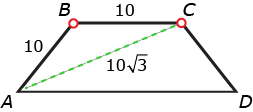Bunuel wrote:
Sides AB, BC, and CD of quadrilateral ABCD all have length 10. What is the area of quadrilateral ABCD?
(1) BC is parallel to AD.
(2) Diagonal AC, which lies inside the quadrilateral, has length 10√3.
Kudos for a correct solution.
MANHATTAN GMAT OFFICIAL SOLUTION:We are told that three of the sides of quadrilateral ABCD have length 10. We are told nothing else about that quadrilateral, and we are asked for its area.
A good way to visualize the constraints is to use “rubber-band geometry.” Picture the three sides that we do know as stiff rods, each of length 10. They are hooked together with flexible hinges, because we know nothing about the angles in the polygon. Finally, the fourth side (AD) is a rubber band – it can stretch and shrink as we flex the hinged rods.

Statement (1): BC is parallel to AD.
Fiddle with the mental contraption of rods and hinges. To make rod BC parallel to the rubber band, you can make either a trapezoid or a parallelogram. This is because the two other sides (AB and CD) have the same length (= 10). The parallelogram will in fact be a rhombus: AD will also have length 10.

Even if you knew which figure was in play, you don’t have a fixed height, so you don’t know the area.
Statement (1) is NOT SUFFICIENT.
Statement (2): Diagonal AC,which lies inside the quadrilateral, has length 10√3.
This statement tells us that triangle ABC is fixed, and it looks something like this:

We don’t need to know the exact angles; all we need to know is that the triangle is fixed in position (and thus has a fixed area). However, CD can swing through any number of angles, making the area of the other triangle (ACD) variable.
Statement (2) is NOT SUFFICIENT.
Statements (1) and (2) TOGETHER: We get the following pictures:

Notice that either picture is possible, as long as the length of the diagonal is longer than that of a square with sides 10. That diagonal would have length 10√2. Since 10√3 is longer, we have the two possibilities above. The trapezoid actually contains the rhombus, so it has a larger area.
Even together, the statements are not sufficient.
The correct answer is E.Attachment:
 1.gif [ 3.93 KiB | Viewed 7564 times ]
1.gif [ 3.93 KiB | Viewed 7564 times ]
Attachment:
 2.gif [ 3.5 KiB | Viewed 7558 times ]
2.gif [ 3.5 KiB | Viewed 7558 times ]
Attachment:
 3.gif [ 3.13 KiB | Viewed 7519 times ]
3.gif [ 3.13 KiB | Viewed 7519 times ]
Attachment:
 4.gif [ 5.09 KiB | Viewed 7517 times ]
4.gif [ 5.09 KiB | Viewed 7517 times ]



 95%
(hard)
95%
(hard)
 64%
(02:13)
wrong
64%
(02:13)
wrong  based on 231
sessions
based on 231
sessions







